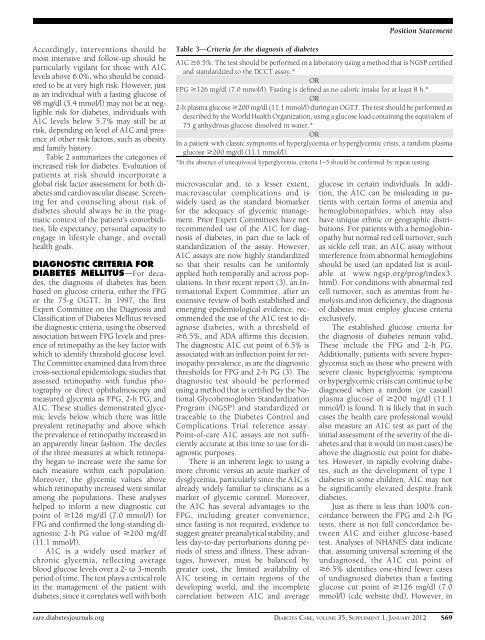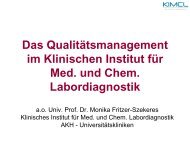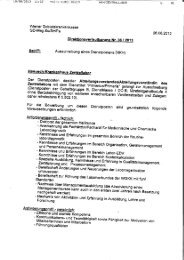Diagnosis and Classification of Diabetes Mellitus
Diagnosis and Classification of Diabetes Mellitus
Diagnosis and Classification of Diabetes Mellitus
You also want an ePaper? Increase the reach of your titles
YUMPU automatically turns print PDFs into web optimized ePapers that Google loves.
Position Statement<br />
Accordingly, interventions should be<br />
most intensive <strong>and</strong> follow-up should be<br />
particularly vigilant for those with A1C<br />
levels above 6.0%, who should be considered<br />
to be at very high risk. However, just<br />
as an individual with a fasting glucose <strong>of</strong><br />
98 mg/dl (5.4 mmol/l) may not be at negligible<br />
risk for diabetes, individuals with<br />
A1C levels below 5.7% may still be at<br />
risk, depending on level <strong>of</strong> A1C <strong>and</strong> presence<br />
<strong>of</strong> other risk factors, such as obesity<br />
<strong>and</strong> family history.<br />
Table 2 summarizes the categories <strong>of</strong><br />
increased risk for diabetes. Evaluation <strong>of</strong><br />
patients at risk should incorporate a<br />
global risk factor assessment for both diabetes<br />
<strong>and</strong> cardiovascular disease. Screening<br />
for <strong>and</strong> counseling about risk <strong>of</strong><br />
diabetes should always be in the pragmatic<br />
context <strong>of</strong> the patient’s comorbidities,<br />
life expectancy, personal capacity to<br />
engage in lifestyle change, <strong>and</strong> overall<br />
health goals.<br />
DIAGNOSTIC CRITERIA FOR<br />
DIABETES MELLITUSdFor decades,<br />
the diagnosis <strong>of</strong> diabetes has been<br />
based on glucose criteria, either the FPG<br />
or the 75-g OGTT. In 1997, the first<br />
Expert Committee on the <strong>Diagnosis</strong> <strong>and</strong><br />
<strong>Classification</strong> <strong>of</strong> <strong>Diabetes</strong> <strong>Mellitus</strong> revised<br />
the diagnostic criteria, using the observed<br />
association between FPG levels <strong>and</strong> presence<br />
<strong>of</strong> retinopathy as the key factor with<br />
which to identify threshold glucose level.<br />
The Committee examined data from three<br />
cross-sectional epidemiologic studies that<br />
assessed retinopathy with fundus photography<br />
or direct ophthalmoscopy <strong>and</strong><br />
measured glycemia as FPG, 2-h PG, <strong>and</strong><br />
A1C. These studies demonstrated glycemic<br />
levels below which there was little<br />
prevalent retinopathy <strong>and</strong> above which<br />
the prevalence <strong>of</strong> retinopathy increased in<br />
an apparently linear fashion. The deciles<br />
<strong>of</strong> the three measures at which retinopathy<br />
began to increase were the same for<br />
each measure within each population.<br />
Moreover, the glycemic values above<br />
which retinopathy increased were similar<br />
among the populations. These analyses<br />
helped to inform a new diagnostic cut<br />
point <strong>of</strong> $126 mg/dl (7.0 mmol/l) for<br />
FPG <strong>and</strong> confirmed the long-st<strong>and</strong>ing diagnostic<br />
2-h PG value <strong>of</strong> $200 mg/dl<br />
(11.1 mmol/l).<br />
A1C is a widely used marker <strong>of</strong><br />
chronic glycemia, reflecting average<br />
blood glucose levels over a 2- to 3-month<br />
period <strong>of</strong> time. The test plays a critical role<br />
in the management <strong>of</strong> the patient with<br />
diabetes, since it correlates well with both<br />
Table 3dCriteria for the diagnosis <strong>of</strong> diabetes<br />
A1C $6.5%. The test should be performed in a laboratory using a method that is NGSP certified<br />
<strong>and</strong> st<strong>and</strong>ardized to the DCCT assay.*<br />
OR<br />
FPG $126 mg/dl (7.0 mmol/l). Fasting is defined as no caloric intake for at least 8 h.*<br />
OR<br />
2-h plasma glucose $200 mg/dl (11.1 mmol/l) during an OGTT. The test should be performed as<br />
described by the World Health Organization, using a glucose load containing the equivalent <strong>of</strong><br />
75 g anhydrous glucose dissolved in water.*<br />
OR<br />
In a patient with classic symptoms <strong>of</strong> hyperglycemia or hyperglycemic crisis, a r<strong>and</strong>om plasma<br />
glucose $200 mg/dl (11.1 mmol/l).<br />
*In the absence <strong>of</strong> unequivocal hyperglycemia, criteria 1–3 shouldbeconfirmed by repeat testing.<br />
microvascular <strong>and</strong>, to a lesser extent,<br />
macrovascular complications <strong>and</strong> is<br />
widely used as the st<strong>and</strong>ard biomarker<br />
for the adequacy <strong>of</strong> glycemic management.<br />
Prior Expert Committees have not<br />
recommended use <strong>of</strong> the A1C for diagnosis<br />
<strong>of</strong> diabetes, in part due to lack <strong>of</strong><br />
st<strong>and</strong>ardization <strong>of</strong> the assay. However,<br />
A1C assays are now highly st<strong>and</strong>ardized<br />
so that their results can be uniformly<br />
applied both temporally <strong>and</strong> across populations.<br />
In their recent report (3), an International<br />
Expert Committee, after an<br />
extensive review <strong>of</strong> both established <strong>and</strong><br />
emerging epidemiological evidence, recommended<br />
the use <strong>of</strong> the A1C test to diagnose<br />
diabetes, with a threshold <strong>of</strong><br />
$6.5%, <strong>and</strong> ADA affirmsthisdecision.<br />
The diagnostic A1C cut point <strong>of</strong> 6.5% is<br />
associated with an inflection point for retinopathy<br />
prevalence, as are the diagnostic<br />
thresholds for FPG <strong>and</strong> 2-h PG (3). The<br />
diagnostic test should be performed<br />
using a method that is certified by the National<br />
Glycohemoglobin St<strong>and</strong>ardization<br />
Program (NGSP) <strong>and</strong> st<strong>and</strong>ardized or<br />
traceable to the <strong>Diabetes</strong> Control <strong>and</strong><br />
Complications Trial reference assay.<br />
Point-<strong>of</strong>-care A1C assays are not sufficiently<br />
accurate at this time to use for diagnostic<br />
purposes.<br />
There is an inherent logic to using a<br />
more chronic versus an acute marker <strong>of</strong><br />
dysglycemia, particularly since the A1C is<br />
already widely familiar to clinicians as a<br />
marker <strong>of</strong> glycemic control. Moreover,<br />
the A1C has several advantages to the<br />
FPG, including greater convenience,<br />
since fasting is not required, evidence to<br />
suggest greater preanalytical stability, <strong>and</strong><br />
less day-to-day perturbations during periods<br />
<strong>of</strong> stress <strong>and</strong> illness. These advantages,<br />
however, must be balanced by<br />
greater cost, the limited availability <strong>of</strong><br />
A1C testing in certain regions <strong>of</strong> the<br />
developing world, <strong>and</strong> the incomplete<br />
correlation between A1C <strong>and</strong> average<br />
glucose in certain individuals. In addition,<br />
the A1C can be misleading in patients<br />
with certain forms <strong>of</strong> anemia <strong>and</strong><br />
hemoglobinopathies, which may also<br />
have unique ethnic or geographic distributions.<br />
For patients with a hemoglobinopathy<br />
but normal red cell turnover, such<br />
as sickle cell trait, an A1C assay without<br />
interference from abnormal hemoglobins<br />
should be used (an updated list is available<br />
at www.ngsp.org/prog/index3.<br />
html). For conditions with abnormal red<br />
cell turnover, such as anemias from hemolysis<br />
<strong>and</strong> iron deficiency, the diagnosis<br />
<strong>of</strong> diabetes must employ glucose criteria<br />
exclusively.<br />
The established glucose criteria for<br />
the diagnosis <strong>of</strong> diabetes remain valid.<br />
These include the FPG <strong>and</strong> 2-h PG.<br />
Additionally, patients with severe hyperglycemia<br />
such as those who present with<br />
severe classic hyperglycemic symptoms<br />
or hyperglycemic crisis can continue to be<br />
diagnosed when a r<strong>and</strong>om (or casual)<br />
plasma glucose <strong>of</strong> $200 mg/dl (11.1<br />
mmol/l) is found. It is likely that in such<br />
cases the health care pr<strong>of</strong>essional would<br />
also measure an A1C test as part <strong>of</strong> the<br />
initial assessment <strong>of</strong> the severity <strong>of</strong> the diabetes<br />
<strong>and</strong> that it would (in most cases) be<br />
above the diagnostic cut point for diabetes.<br />
However, in rapidly evolving diabetes,<br />
such as the development <strong>of</strong> type 1<br />
diabetes in some children, A1C may not<br />
be significantly elevated despite frank<br />
diabetes.<br />
Just as there is less than 100% concordance<br />
between the FPG <strong>and</strong> 2-h PG<br />
tests, there is not full concordance between<br />
A1C <strong>and</strong> either glucose-based<br />
test. Analyses <strong>of</strong> NHANES data indicate<br />
that, assuming universal screening <strong>of</strong> the<br />
undiagnosed, the A1C cut point <strong>of</strong><br />
$6.5% identifies one-third fewer cases<br />
<strong>of</strong> undiagnosed diabetes than a fasting<br />
glucose cut point <strong>of</strong> $126 mg/dl (7.0<br />
mmol/l) (cdc website tbd). However, in<br />
care.diabetesjournals.org DIABETES CARE, VOLUME 35, SUPPLEMENT 1, JANUARY 2012 S69




